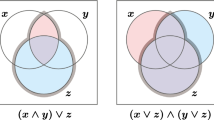Abstract
In this paper, we investigate the following problem: give a quasi-Boolean function Ψ(x 1, …, x n ) = (a ∧ C) ∨ (a 1 ∧ C 1) ∨ … ∨ (a p ∧ C p ), the term (a ∧ C) can be deleted from Ψ(x 1, …, x n )? i.e., (a ∧ C) ∨ (a 1 ∧ C 1) ∨ … ∨ (a p ∧ C p ) = (a 1 ∧ C 1) ∨ … ∨ (a p ∧ C p )? When a = 1: we divide our discussion into two cases. (1) ℑ1(Ψ,C) = ø, C can not be deleted; ℑ1(Ψ,C) ≠ ø, if S 0 i ≠ ø (1 ≤ i ≤ q), then C can not be deleted, otherwise C can be deleted. When a = m: we prove the following results: (m∧C)∨(a 1∧C 1)∨…∨(a p ∧C p ) = (a 1∧C 1)∨…∨(a p ∧C p ) ⇔ (m ∧ C) ∨ C 1 ∨ … ∨C p = C 1 ∨ … ∨C p . Two possible cases are listed as follows, (1) ℑ2(Ψ,C) = ø, the term (m∧C) can not be deleted; (2) ℑ2(Ψ,C) ≠ ø, if (∃i 0) such that \(S'_{i_0 } \) = ø, then (m∧C) can be deleted, otherwise ((m∧C)∨C 1∨…∨C q )(v 1, …, v n ) = (C 1 ∨ … ∨ C q )(v 1, …, v n )(∀(v 1, …, v n ) ∈ L n3 ) ⇔ (C ′1 ∨ … ∨ C ′ q )(u 1, …, u q ) = 1(∀(u 1, …, u q ) ∈ B n2 ).
Similar content being viewed by others
References
Hammer P L, Rudeanu S (1968) Boolean methods in operations research and related areas. Springer-Verlag, Berlin
Hammer P L, Kogan A (1992) Horn functions and their DNF’s. Information Processing Lette. 44: 23–29
Boros E, Ibaraki T and Makino K (1999) Logical analysis of binary data with missing bits. Artificial Intelligence 107: 219–263
Bshouty N H (1995) Exact learning Boolean functions via the monotone theory. Information and Computation 123: 146–153
Boros E, Crama Y, Hammer P L (1990) Polynomial time inference of all valid implications for horn and related formulae. Annals of Mathematics and Artificial Intelligence 1: 21–32
Boros E, Gurrich V, Hammer P L, Ibaraki T and Kogan A (1995) Decompositions of partially defined Boolean functions. Discrete Applied Mathematics 62: 51–75
Boros E, Hammer P L, Minoux M, Rader D (1999) Optimal cell flipping to minimize channel density in VLSI design and pseudo-Boolean optimization. Discrete Applied Mathematics 90: 69–88
Ekin O, Foldes S, Hammer P L, Hellerstein L (2000) Equational characterizations of Boolean function classes. Discrete Mathematics 211: 27–51
Fraenkel A S, Hammer P L (1984) Pseudo-Boolean functions and their graphs. Annals of Discrete Mathematics 20: 137–146
Simeone B (1979) A generalized consensus approach to non-linear 0–1 optimization. Research Report, University of Waterloo, Department of Combinatorics and Optimization: 79–83
Davio M, Deschamps J P, Thayse A (1978) Discrete and switching functions. McGraw Hill.
Foldes S, Hammer P L (2000) Monotone, horn and quadratic pseudo-Boolean functions. Journal Of Universal Computer Science 6(1): 97–104
Foldes S, Hammer P L (2000) Disjunctive and conjunctive representations in finite lattices and convexity spaces. Rutgers University, RUTCOR Research Reports, RRR12-2000
Quine W V (1955) A way to simplify truth function. American Mathematical Monthly 62: 627–631
Van de Vel M (1993) Theory of convex structures. North-Holland
Störmer H (1990) Binary functions and their applications. Springer-Verlag, Berlin
Hammer P L, Rosenberg I G, Rudeanu S (1963) On the minimization of pseudo-Boolean function. Stud. Cerc. Matem. 14: 359–364
Gottschalk W H (1953) The theory of quaternality. Jounal of Symbolic Logic 18: 193–196
Author information
Authors and Affiliations
Corresponding author
About this article
Cite this article
Cheng, Yj., Xu, Lx. Properties of quasi-Boolean function on quasi-Boolean algebra. Fuzzy Inf. Eng. 3, 275–291 (2011). https://doi.org/10.1007/s12543-011-0083-8
Received:
Revised:
Accepted:
Published:
Issue Date:
DOI: https://doi.org/10.1007/s12543-011-0083-8




